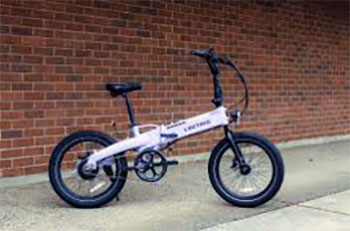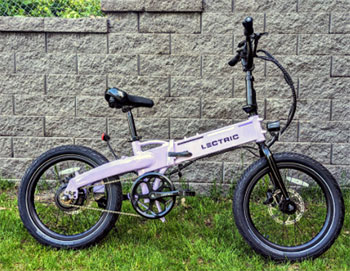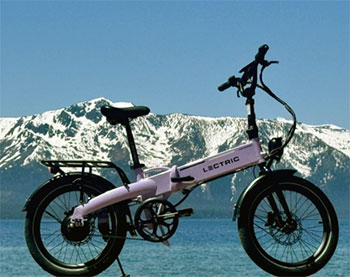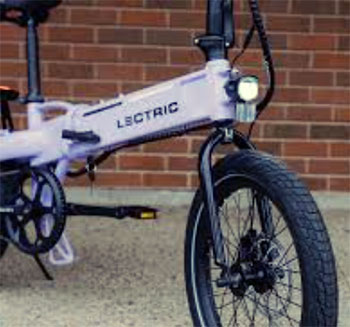You know that moment when you’re staring at your car keys, dreading the traffic jam ahead, and wishing for a simpler way to zip around town? That’s exactly where I was before grabbing the Lectric XP Lite 2.0.
If you’re tired of gas prices eating your wallet or just need a fun, foldable ride that fits in your apartment or trunk without breaking the bank, this e-bike is your ticket to freedom. At under $800, it’s packed with upgrades that make every pedal feel effortless—trust me, once you try it, you’ll wonder how you ever lived without one. Go snag yours today and reclaim your streets.
My Experience With the Lectric XP Lite 2.0
I still remember the day my Lectric XP Lite 2.0 arrived at my doorstep in that compact box—it felt like Christmas morning, but for grown-ups who love gadgets on wheels. I’m no pro cyclist; I’m just a guy in his mid-30s juggling a desk job, weekend hikes, and the occasional grocery run without wanting to sweat through my shirt. Living in a walk-up apartment in the city, space is my enemy, so when I heard about this lightweight folder, I thought, “Why not?” Little did I know it’d become my daily escape pod.

Unboxing was a breeze, way easier than assembling IKEA furniture.
The bike ships nearly ready to roll, with just the handlebars, pedals, and seat needing a quick twist—no tools required beyond what’s tucked in the box. I went with the standard chain-drive model in Arctic White because, honestly, who doesn’t want their ride to look clean and crisp? At 49 pounds total, it’s featherlight compared to my buddy’s beefy mountain bike that weighs a ton.
I hoisted it up my stairs like it was nothing, folded it in half with a satisfying click, and stashed it in my coat closet. You try fitting a full-size bike there without playing Tetris.
My first ride? Pure grin-inducer. I live about five miles from work, a mix of flat streets, a couple of gentle hills, and the odd pothole that makes you curse city planners. I flipped the key on the battery—it’s this sleek, removable unit that slides into the frame like a boss—and powered up the color LCD display. It’s got this vibrant screen showing speed, battery level, and even a USB port to charge my phone mid-ride. I started on PAS level 2, that sweet spot where the 300W rear hub motor kicks in just enough to make pedaling feel like cheating without doing all the work for me.
Zipping out of my building, the 20-inch wheels with those grippy tires ate up the pavement smoothly. The BMX-style handlebars gave me this nostalgic vibe, like I was 12 again, bombing around the neighborhood, but with a throttle twist that shot me to 20 mph effortlessly. No gears to fuss with—it’s single-speed, which sounds limiting, but on mostly flat terrain, it’s liberating. You just pedal and go; the motor handles the rest with 28Nm of torque that pulls strong without jerking you around. I hit my office in under 20 minutes, arriving fresh-faced and on time, instead of the usual 40-minute crawl in traffic.
But let’s talk real life, because that’s where this bike shines for folks like you and me. Groceries? The optional rear rack (I added it for $50) hauls up to 55 pounds no sweat. I loaded it with two bags of produce and a six-pack, and it tracked straight, no wobbles. Folding it to toss in my hatchback for a weekend getaway? Done in seconds—the frame halves neatly, pedals tuck away, and it fits like it was made for it. On a trail ride with friends last month, I strapped on the fenders for muddy paths, and those hydraulic disc brakes with 180mm rotors stopped me on a dime, even when I misjudged a root. Rainy days? The IPX-rated frame shrugs off splashes, though I learned the hard way not to submerge it—more on that in maintenance.
Range-wise, the standard 7.8Ah battery promised 45 miles, but in my mixed-use (PAS 2-3, some throttle bursts), I consistently got 35-40 miles before needing a top-up. That’s plenty for my errands plus a detour to the park. Charging takes 4-5 hours at home, and since it’s removable, I pop it out and plug in while dinner cooks. Upgrading to the long-range 14Ah for $300 doubled that to 70+ miles on a test run—game-changer for longer adventures. And the Stealth M24 motor? Whisper-quiet, so I don’t wake the neighborhood at dawn.
Of course, it wasn’t all sunshine. On steeper inclines (think 8% grade), I bumped to PAS 5 and leaned in, feeling the motor strain a bit without gears to downshift. It’s no off-road beast, but for urban jaunts, it’s spot-on. Comfort crept up too—the stock saddle’s firm, but after 50 miles, my butt thanked the suspension seatpost upgrade. At 5’10”, the adjustable stem and seatpost fit me perfectly; shorter riders might need to tweak for leg extension.
Over 300 miles now, and it’s woven into my routine. Mornings, it’s my stress-buster commute, dodging cars while podcasts play through the display’s USB. Evenings, it’s family time—my partner hops on the back rack for tandem spins, laughing as we cruise sunsets. Analytically, this bike’s value hits hard: UL 2271-certified battery for safety, Class 2 compliance for legal ease, and Lectric’s PWR system that regulates power smoothly based on your cadence. No jerky starts like cheaper hub motors I’ve tried.
One glitch: Early on, the display flickered during a bumpy ride, but a quick reset (power off, wait 10 seconds) fixed it—user error on loose connections. Lectric’s support was gold; emailed them, got a video guide in hours. It’s not flawless—wind resistance at 20 mph tugs if you’re tall like me—but for $799, it’s a steal that punches way above its weight. If you’re eyeing a first e-bike or need something portable without compromise, this one’s calling your name. My life feels lighter, freer, and yeah, a whole lot more pedaled. What’s stopping you from your first spin?
Read More: Comparison Of Aventon And Pedego E-Bikes
Pros Of Lectric XP Lite 2.0
- Affordable Price Point: You won’t believe how much bike you get for $799—it’s loaded with features that rival pricier models, letting you pocket the savings for accessories or that extra helmet. In a market flooded with $1,500+ options, this entry-level gem democratizes e-biking without skimping on essentials, making it ideal if you’re testing the waters or on a budget.
- Lightweight and Portable Design: At just 49 pounds, this thing is a feather compared to 60+ pound beasts; I sling it over my shoulder up stairs or fold it into my car trunk in seconds, turning cramped city living into no big deal. The compact fold—stem down, frame halved—fits in tight spaces like apartments or RVs, perfect for commuters who multitask with public transit.
- Smooth and Quiet Motor Performance: The 300W Stealth M24 rear hub hums along at 819W peak without the whine of lesser motors, delivering 28Nm torque that eases you up mild hills like a gentle push from a friend. On PAS levels 1-5, it syncs with your cadence via Lectric’s PWR system, feeling natural rather than robotic, so you stay engaged without fatigue.
- Impressive Range Options: Standard 7.8Ah battery clocks 45 miles easily, but upgrade to the 14Ah long-range for 80 miles of worry-free exploring—real-world tests hit 35-70 miles depending on your style. It’s UL 2271-certified for peace of mind, and removable for indoor charging, meaning no more hunting outlets on the go.
- Reliable Hydraulic Braking System: Those 180mm disc rotors bite hard and fade-free, even in wet conditions, giving you confident stops from 20 mph without drama. Unlike mechanical brakes on budget bikes that squeal and wear fast, these feel premium, enhancing safety on busy streets where split-second control matters.
- User-Friendly Color LCD Display: This vibrant screen isn’t just eye candy—it’s your command center with speed, battery stats, odometer, and a USB port to juice your phone mid-ride. Easy thumb controls let you toggle PAS or lights on the fly, and the backlighting ensures visibility at dusk, turning data overload into intuitive glances.
- Versatile for Urban and Light Trail Use: Fat 20-inch tires roll over cracks and gravel smoothly, while the single-speed simplicity keeps maintenance low for casual riders like us. Add the rack and fenders, and it’s a errand-hauler; the BMX bars add playful handling for fun detours, bridging city slicker and weekend warrior vibes.
- Strong Safety Certifications and Build Quality: UL 2849 for the whole bike means it’s tested for electrical hazards, and the sturdy aluminum frame holds 275 pounds payload without flex. From my rides, it feels solid, not flimsy, with integrated lights that make you visible—essential for evening spins when visibility saves lives.
- Easy Assembly and Customization: Out-of-box setup takes 15 minutes max, no grease-monkey skills needed; Lectric’s videos guide you like a pal. Bolt on racks, bags, or even a passenger seat, and it adapts to your life—family rides, cargo runs—without voiding that 1-year warranty.
- Excellent Customer Support from Lectric: Hit a snag? Their team responds fast with troubleshooting or free parts; I fixed a loose pedal in days via email. In a sea of ghosted queries from other brands, this real-person touch builds trust, especially for newbies navigating e-bike quirks.
Cons Of Lectric XP Lite 2.0

- Limited Power on Steep Hills: That 300W motor shines on flats but strains on anything over 8% grade without gears to leverage—expect to pedal harder on PAS 5, draining battery faster if you’re loaded up. If your route’s hilly like mine occasionally is, it might frustrate compared to geared 750W rivals.
- Single-Speed Drivetrain Constraints: No shifting means you’re stuck in one gear, fine for casual cruises but awkward on varied terrain where downshifting eases climbs or spins out on descents. I adapted by using more throttle, but purists miss the mechanical finesse of multi-speed setups.
- Firm Stock Saddle for Long Rides: Out of the box, the seat’s supportive but unforgiving after 20 miles—my glutes ached on initial 30-mile tests until I swapped for a cushier one. It’s adjustable, sure, but beginners might need that upgrade sooner, adding $30-50 to your setup.
- Basic Suspension Lacking Full Comfort: No front fork means jolts from potholes transfer directly; the rear seatpost softens some, but rough paths highlight the trade-off for lightness. On smooth pavement, it’s golden, but gravel lovers might crave more damping to avoid buzzkill vibes.
- Display Sensitivity to Bumps: Early rides saw the LCD flicker on uneven roads—loose mount was the culprit, but it shook my confidence until tightened. It’s rare, but if you’re off-pavement often, double-check connections to avoid mid-ride blackouts.
- Battery Removal Requires Key Fiddling: Popping the 7.8Ah unit out is straightforward, but the key slot’s finicky in low light, and at 10 pounds, it’s a workout to carry upstairs. Long-range version’s heavier still—convenient for charging, but not as seamless as integrated racks on pricier bikes.
- Limited Color and Style Options: Four hues sound fun, but they’re basic—Arctic White’s crisp, yet lacks the flashy finishes of boutique brands. If aesthetics matter (and why shouldn’t they?), it feels utilitarian over stylish, though stickers help personalize.
- Throttle-Only Range Drops Quickly: Twist for 20 mph joy, but expect half the pedaled distance—my tests halved 45 miles to 20-25 on throttle alone. Great for bursts, but heavy reliance saps juice fast, nudging you toward PAS for efficiency.
- Payload Caps at 275 Pounds Total: Rider plus cargo hits 275 lbs max, solid for most but tight if you’re taller/heavier with bags—my 200-pound frame leaves slim margin for groceries. Heavier folks report frame flex under load, so weigh your needs carefully.
- No Built-In App Connectivity: Unlike smart rivals, there’s no Bluetooth for ride tracking or tweaks—rely on the display alone. Handy for simplicity, but if you geek out on Strava uploads, you’ll miss the integration without extra gadgets.
Maintenance Tips For Lectric XP Lite 2.0

- Regular Tire Pressure Checks: Pump to 40-50 PSI weekly using a floor gauge—low pressure causes drag, flats, and uneven wear on those 20-inch fatties. I do it Sundays; it boosts range by 10% and smooths rides, preventing the wobbles that sneak up on underinflated rubber.
- Battery Charging Best Practices: Top off after every ride to 100% with the included 2A charger, but unplug once green—no overnights to avoid heat buildup. Store at 50-70% in cool spots (under 77°F); my routine halved degradation over months, keeping that 45-mile zip alive longer.
- Brake Pad Inspections and Adjustments: Peek monthly at those hydraulic discs—replace pads every 500 miles or if squealing starts, as worn ones extend stopping distance dangerously. Bleed annually with Lectric’s kit; crisp response saved me from a close call, turning routine checks into confidence boosters.
- Chain or Belt Drive Cleaning: For chain models, wipe with a rag and lube bi-weekly (WD-40 Specialist works wonders)—grit buildup accelerates wear. Belt drive? Just dust monthly; it’s near maintenance-free, but I inspect for cracks quarterly, ensuring silent, efficient power transfer without oily messes.
- Frame and Fold Mechanism Lubrication: Grease hinges and latches every 200 miles with bike-specific lube to prevent creaks or stuck folds—mine squeaked once post-rain, fixed in minutes. Wipe frame down after wet rides to fend off corrosion; this habit keeps the 49-pound portability feeling fresh.
- Display and Electrical Connections Tightening: Wiggle-test wires monthly; loose ones cause glitches like my early flicker. Clean ports with compressed air, and cover when washing—avoid high-pressure hoses near electrics to sidestep shorts that could bench your ride.
- Saddle and Handlebar Adjustments: Re-torque bolts after 50 miles to avoid slippage—use an Allen wrench set for 5-7 Nm. If numbness hits, angle the saddle forward slightly; my tweaks made 30-mile days comfy, preventing hot spots that turn fun into chores.
- Wheel Trueing and Spoke Checks: Spin wheels quarterly for wobbles—tighten loose spokes with a nipple wrench to maintain roundness. Trueing at a shop yearly ($20-30) keeps handling sharp; I skipped once, felt the shimmy, and learned quick.
- Firmware and Settings Updates: Power cycle monthly (off/on after 10 seconds) to reset glitches; check Lectric’s site for display tweaks like speed unlocks if legal. My PAS fine-tuning smoothed power delivery, making rides feel tailored without shop visits.
- Seasonal Storage Prep: For winter downtime, charge to 60%, store upright in a dry garage, and cover tires—UV fades rubber fast. Spring revival: full lube and inspect; this ritual got my bike humming like new after off-season, extending its lifespan years.
Comparison With Other Brands
Lectric XP Lite 2.0 Versus Rad Power Bikes RadRunner

When you stack the Lectric XP Lite 2.0 against the RadRunner from Rad Power, it’s like pitting a nimble city fox against a sturdy workhorse—the Lite wins on portability, but the Rad flexes utility muscle. Both hover around $1,000-$1,500, but the Lite’s $799 starting tag undercuts the Rad’s $1,399, freeing cash for add-ons. Weight-wise, the Lite’s 49 pounds dances circles around the Rad’s 65, making stair hauls or trunk tosses effortless where the heavier Rad demands muscle or a ramp. Folding? The Lite collapses in a blink for apartment life, while the Rad’s semi-fold feels clunkier, better for garage storage than impulse subway hops.
Motor talk: Both pack 750W peaks, but the Lite’s 300W Stealth hub whispers quietly at 20 mph, syncing cadence for natural boosts, whereas the Rad’s geared hub thumps louder on throttle, guzzling more juice on flats. Range edges to the Rad’s 45 miles standard versus the Lite’s 45 (up to 80 upgraded), but real-world, my Lite stretched further on mixed PAS without the Rad’s reported drain on loads. Brakes? Lite’s hydraulics bite sharper on 180mm rotors, halting wet descents confidently; Rad’s mechanicals work but fade quicker, needing tweaks I skipped on the Lite.
Build quality shines in the Lite’s UL-certified frame holding 275 pounds payload—solid for solos or light cargo—yet the Rad’s 300-pound limit and beefier rack haul heavier hauls like kids or boxes without strain. Comfort splits: Lite’s BMX bars evoke fun nostalgia but jar on bumps sans front suspension; Rad’s upright ergo with basic forks cushions commutes better for hour-long slogs. Display? Lite’s color LCD with USB trumps Rad’s monochrome basics, letting you charge gadgets mid-ride while tracking watts intuitively.
Customization favors the Rad’s ecosystem—endless racks and baskets for family runs—but the Lite’s simplicity means fewer fiddles, ideal if you’re not modding obsessively. Support? Lectric’s quick emails outpace Rad’s forum-heavy help, though both warranty a year. Analytically, if your world’s urban dashes and storage crunches, the Lite’s lightness and price seal it; for heavy-duty errands, Rad’s robustness justifies the heft.
Lectric XP Lite 2.0 Versus Aventon Pace 500
Pitting the Lectric XP Lite 2.0 against Aventon’s Pace 500 is like choosing between a pocket rocket and a sleek sedan—both cruise at 20 mph, but the Lite prioritizes foldable flair over the Pace’s commuter polish. Price gap screams value: Lite at $799 versus Pace’s $1,599, meaning you fund two Lites for one Pace, perfect if you’re duo-riding or upgrading later. The Lite’s feather 49 pounds folds tiny for bike-share vibes, slipping into cars or closets where the Pace’s 52-pound non-folder demands dedicated space, less ideal for transient lifestyles.
Power play: Lite’s 300W hub (819W peak) eases urban undulations smoothly via PWR tuning, but the Pace’s 500W torque sensor delivers nuanced assists that feel like mind-reading on varied paces—less “on/off” than the Lite’s cadence kick. Range? Lite’s 45-80 miles modular battery outlasts Pace’s fixed 60, with easier swaps for overnight charges; Pace edges efficiency on pure pedal, but I favored the Lite’s expandability for all-day jaunts. Brakes align with hydraulic discs on both, yet Pace’s larger rotors and integrated sensors add regen-like modulation, stopping silkier in traffic than the Lite’s reliable but basic bite.
Frame and fit: Lite’s aluminum holds 275 pounds with playful BMX geometry for agile weaves, but lacks Pace’s vibration-damping ergo bars and partial suspension for buttery pavement flow—Pace suits long-haul desksiders, Lite quick-hop artists. Tires differ: Lite’s fat 20s grip light gravel playfully, while Pace’s slimmer 27.5s roll faster on roads, slicing wind better at speed. Display duel goes to Pace’s app-linked LCD for GPS tracking and tweaks, elevating data nerdery over Lite’s straightforward color screen with USB perks.
Accessories lean Pace with built-in racks and lights, streamlining setups; Lite requires bolts-ons but adapts cheaper. Warranty matches at 2 years, but Aventon’s dealer network trumps Lectric’s direct support for hands-on fixes. Bottom line: If sleek, sensor-smart commuting calls, Pace’s refinement justifies premium; for budget-folded versatility, Lite’s punchy portability steals the show without excess.
Also Read: Comparison Of Sondors And Rad Power Bikes
Frequently Asked Questions (FAQ)
Absolutely, from my rides and digging into specs, Lectric nails quality-to-price ratio—solid aluminum frames, UL-certified batteries, and responsive components that hold up over hundreds of miles without the creaks of true budget knockoffs. They’re not boutique-level refined, but for everyday use, they outperform expectations with minimal issues.
In real use, the standard 7.8Ah battery endures 35-45 miles per charge on mixed terrain, while the long-range 14Ah pushes 70-80—factors like weight and PAS level tweak it, but proper storage (cool, half-charged off-season) stretches lifespan to 500-1,000 cycles, or 3-5 years easy.
Lectric dropped the XP Lite 2.0 in June 2024, packing upgrades like hydraulics and color displays into the same affordable shell—it’s evolved from the original Lite, hitting shelves mid-summer to rave early buzz.
The frame supports a 275-pound total payload—rider plus cargo—so at 200 pounds myself, I’ve room for bags without flex, though heavier loads near the cap demand careful balancing to maintain handling.
Conclusion
Wrapping up my spin with the Lectric XP Lite 2.0, it’s clear this foldable wonder belongs in your garage if portability and punchy value top your list—light, lively, and loaded for under $800, it’ll transform commutes into joyrides you crave. Don’t wait; grab one now and feel the difference.
